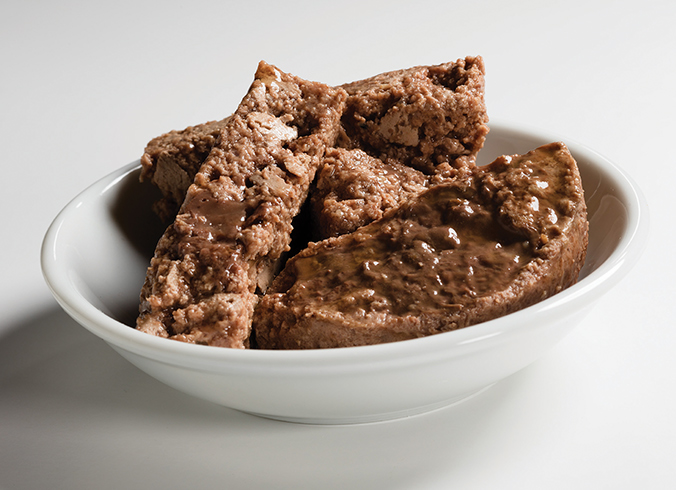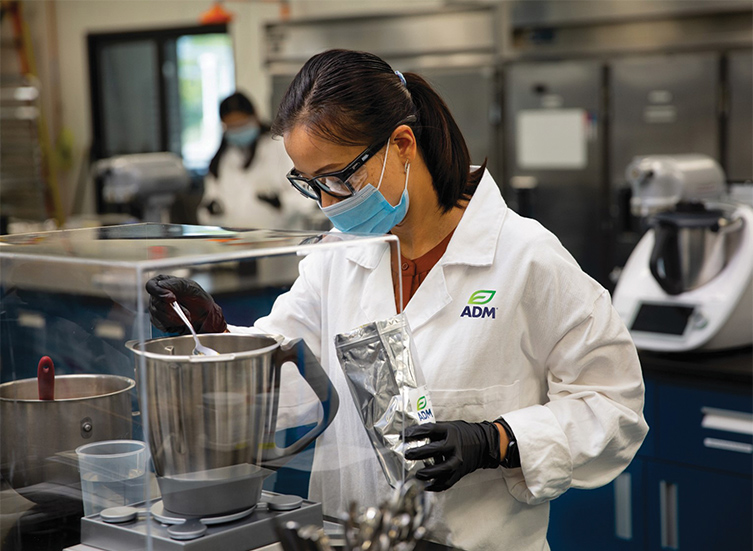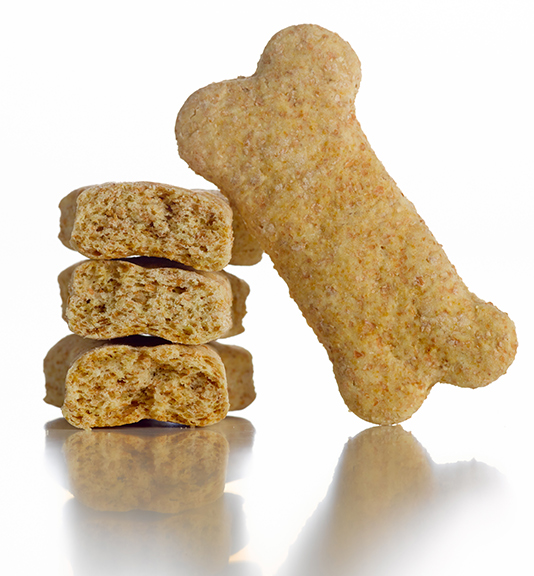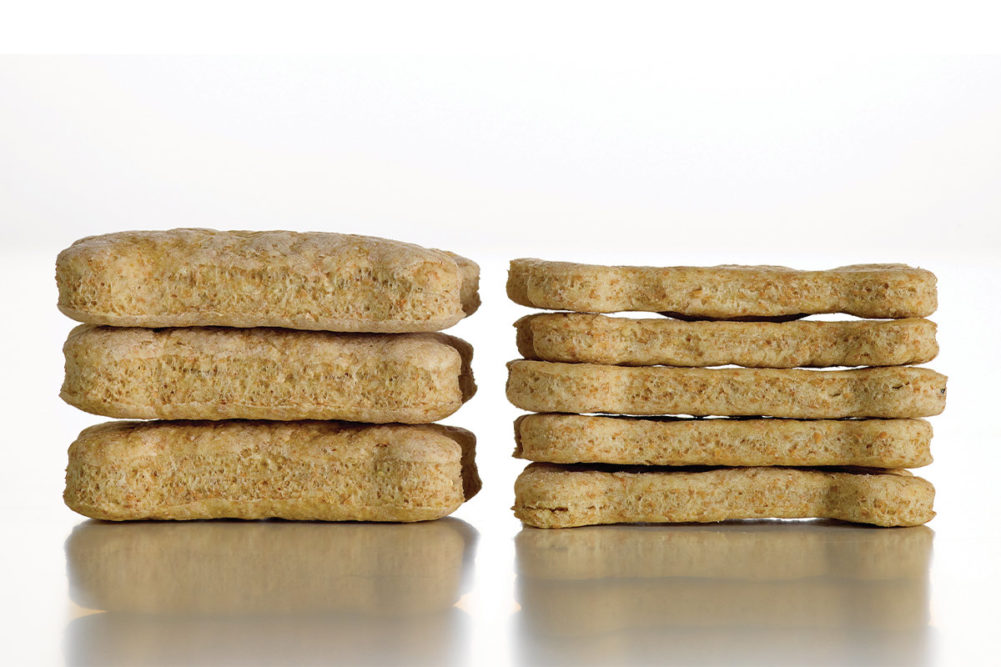This article was published in the June 2021 issue of Pet Food Processing. Read it and other articles from this issue in our June digital edition.
Whether a pet food or treat is pureed, shredded, cubed, cut, jellied, gravied, chewy, soft, crunchy, hard, abrasive or otherwise, final product texture is paramount. Texture is as much about formulation as it is about process parameters. Amy McCarthy, vice president, Pet Nutrition, ADM Animal Nutrition, Decatur, Ill., described this as “a balance of science and art.”
“Science drives the chemical and physical interactions that impact product performance during production,” she explained. “The art lies with the skill of an experienced operator who makes necessary equipment adjustments during production to ensure the integrity and desired characteristics of the final product.”
According to Patrick Luchsinger, manager, marketing and business development, Ingredion Incorporated’s pet food segment, Westchester, Ill., factors influencing final product texture can be boiled down into five categories: processing conditions, ingredient variability, the shape of the final product, nutrient content, and the types and levels of palatants used. Processing considerations include moisture, temperature and cooking time, while ingredient variability can include particle size and the percentages of fat, starch, protein and fiber.
“Using the right starch, flour, protein or gum in the right application can help significantly in achieving the right texture and appealing to the animal for repeat feeding pattern,” said Patrick Luchsinger, Ingredion Incorporated.
The complexities behind formulating for texture come down to a few ingredients, which essentially manage the amount of moisture in a product, its viscosity and porosity, all varying between dry extruded food and treats, baked goods and wet products.
“To produce the targeted texture for any pet food or treat, formulations require a balance of oil, protein and moisture in the product,” said Brock Lundberg, Ph.D., president, research and development and applications, Fiberstar, Inc., River Falls, Wis.
In turn, texture affects the final product’s palatability — or acceptance — shape, density and shelf-life, regardless of the format.
“The main keys to any successful pet food or treat besides palatability and aroma to attract the animal are mouthfeel, which is primarily driven by texture, and shelf stability, both visually and chemically,” said Joel Bartley, research scientist, animal nutrition, IsoNova Technologies, LLC, Springfield, Mo. “The texture of the product can affect these because of surface area, product porosity, and ability to retain fat.”
Starches, gums and oils
In many cases, achieving optimal texture is a balancing act. In a kibble manufacturing process, high-starch ingredients are key in determining the final texture, density and shape of a product, McCarthy said. Bartley added the process impact on texture is “much more acute” for dry pet food and treats, “because the texturizing process is much faster than in wet foods or baked products.”
 Cats are particularly sensitive to changes in texture, making product acceptance and consistency key for processors in this segment. (Source: Ingredion Incorporated)
Cats are particularly sensitive to changes in texture, making product acceptance and consistency key for processors in this segment. (Source: Ingredion Incorporated) “Dry pet foods need to have low water activity for maximal shelf-life and freshness, which typically equates to harder products,” explained Robert Mason, senior applications scientist, Balchem Animal Health and Nutrition, New Hampton, N.Y. “Starches, pre-gelatinized starches and proteins are some macro ingredients that are typically used to add hardness.”
Raw materials can also influence a final product’s texture.
“Courser ground ingredients will provide a rougher texture in the finished product and may give a more natural appearance,” said Kent Cooper, co-owner, Evolve Consulting Group, Fremont, Neb. “Conversely, finer ground raw materials will provide a clean, consistent finished product look from run to run.”
Moisture content and temperature affect how starch is cooked, “which thus affects the product texture,” according to Ellis Liu, technical manager, Ingredion’s pet food segment. In order for the starch to gelatinize, higher temperatures may be needed during processing. The form of gelatinized starch is dependent on equipment factors, Liu added, including shear, pressure and throughput, all of which can also affect the texture of the final product.
“Ingredion’s ingredient solutions for texture include starches, flours, sweeteners, prebiotic fibers and plant proteins,” Luchsinger said. “Our ingredients come from many different bases such as potato, rice, tapioca, pea, lentil, chickpea, guar and many others that all have different functionalities to address texture.”
Fiberstar’s citrus fiber ingredient, Citri-Fi, can tightly bind large quantities of fats and oils for extrusion applications, ingredients which can otherwise hinder the processes of mixing and shearing that occur inside the extruder. This ingredient is upcycled from byproducts of the citrus juicing industry, meeting natural, sustainable and clean-label product specifications on top of its binding and emulsification abilities.
“The total starch level and ratio of amylose and amylopectin can affect water-holding capacity, gelatinization, dough expansion, viscosity and final density,” McCarthy explained. “Balancing the ratio of amylose and amylopectin supports maximum kibble expansion to ensure structural integrity while minimizing fines. Protein and fat can also influence dough expansion, which impacts product density and texture.”
“The textures of the foods can vary based on kibble size, shape, and base proteins and starches,” said Robert Mason, Balchem Animal Health and Nutrition.
Mason pointed out some processors will inject air or water vapor during production to stimulate dough expansion and increase porosity, while others use a chemical-based leavening process to more efficiently achieve this.
“In food systems, this is commonly done with ingredients like baking powder, but pet systems can be more challenging with higher usage of organic acids and protein meals,” he said.
Balchem offers a range of encapsulated sodium bicarbonates to help processors control gas formation during production, yielding increased porosity. It also provides encapsulated acidulants that can be used in conjunction with sodium bicarbonates to facilitate leavening processes.
Semi-moist pet food and treat products require starches or gums to maintain the product’s softness over longer periods of time to deliver consistent quality.
“Glycerin and other types of humectants are important ingredients in semi-moist products to maintain a chewy texture while also controlling water activity to optimize product quality and safety,” McCarthy said.
 If a product’s texture is off, it will affect several crucial aspects including palatability, shelf-life stability and acceptance by the animal. (Source: ADM)
If a product’s texture is off, it will affect several crucial aspects including palatability, shelf-life stability and acceptance by the animal. (Source: ADM) Mason pointed out the use of gums can also bind water and improve flowability, helping the product contain more moisture while lowering water activity. He suggested “a combination of proteins with grains/legumes to impart flexibility and allow the proteins — once dried and utilized humectants — to retain moisture, but still have low water activities for acceptable shelf-life.”
Oil binding ingredients can also facilitate productive shearing during processing. For semi-moist pet food and treats, Fiberstar’s Citri-Fi ingredients work to bind both oil and water and remain thermally stable, ensuring the product does not dry out prematurely.
Citri-Fi ingredients can bind up to 10 times their weight in water and eight times their weight in oil, allowing them to be incorporated in extruded, baked or semi-moist pet food and product formulations at low usage rates.
Starches and gums also play a key role in determining the textures of wet pet food products, McCarthy said.
“Wet foods have very high moisture contents and will utilize a combination of protein sources and starches/gums to control product firmness and resilience,” Mason said. “Pâté-style foods are expected to maintain a loaf-like appearance and have enough body to maintain this shape, while chunk and gravy should have firmer meat pieces and a flowable gravy.”
To achieve the desired “flowable gravy” for shredded or soupy wet pet food products, Bartley said, “binding ingredients are added to improve the impact the cooking process has on texture, and ensure the texture stays stable throughout retort.”
Balchem offers encapsulated calcium lactate and sodium alginate to aid in water binding and reinforce protein structure, increasing firmness and improving handleability.
Rough edges
Clearly, achieving the correct product texture is no small undertaking. Processors face both ingredient and production challenges along the way.
“Some of the common challenges are the spectrum of allowable ingredients, target nutrient levels (moisture, fat, protein), the shape of pet food, labeling, and the type of equipment and processing conditions used for manufacturing,” Bartley said. “Many of these challenges are related and they all manifest themselves differently depending on the type of product being made.”
 Leavening is important for achieving the right texture in baked treats, like the ones seen here, as it impacts product density, structural integrity and texture. (Source: Balchem)
Leavening is important for achieving the right texture in baked treats, like the ones seen here, as it impacts product density, structural integrity and texture. (Source: Balchem) As the number of pet food and treat SKUs grows, processors are posed with increasing ingredient limitations to create cleaner, more natural, sustainable and, generally, higher-quality products.
“Ingredient restriction is a common challenge in achieving the right texture,” Liu said. “More often than not, the formulator is only allowed to use certain ingredients to deliver specific free-from claims. In addition, the cost, the order of ingredients in the ingredient statement, as well as guaranteed analysis are also challenges because of the ingredient restriction.”
Choosing the right processing aid — and determining the appropriate amount to be included — is crucial for product success.
“One of the challenges to achieving the right texture is incorporating oil into the formula, which can result in process challenges and separation during shelf life,” Lundberg said. “On the other hand, not adding enough oil into the system will cause the pet food to dry out too quickly.”
Fiberstar’s Citri-Fi® ingredient can bind both water and oil and remain thermally stable, preventing product from drying out before its shelf life is spent. Citri-Fi can also reduce crumbling of biscuit treats.
“Another challenge comes from the increasing usage of novel raw protein materials, organ meats, legumes, and so on,” Mason said. “These materials may offer a variety of nutritional, sustainability or front of pack benefits, but frequently do not carry the same functional performance of the ingredients they are replacing.”
The impact of various processing methods — extrusion, baking and the use of retort ovens — should also be considered. Stability will be impacted by the amount of heat involved, shear forces, and fat and moisture contents, Lundberg said.
On-trend innovations
Luckily, ingredient suppliers are stepping up to offer cutting-edge texture solutions for this evolving market.
“Alginates, a seaweed extract, are functional hydrocolloids on their own, but with added calcium ions they can form cold set, thermo-irreversible gels,” Mason said. “This technology is beneficial for a variety of applications, from stabilizing raw protein co-products too fluid for skeletal muscle applications, improving product firmness or flexibility, and thickening gravies.”
 When formulating for texture, processors must consider any ingredient restrictions or labeling requirements, equipment and processing attributes, and how the ingredients and processes affect one another. (Source: ADM)
When formulating for texture, processors must consider any ingredient restrictions or labeling requirements, equipment and processing attributes, and how the ingredients and processes affect one another. (Source: ADM) To address recent labeling trends, Ingredion offers a clean-label starch with viscosity and shelf-life stability levels comparable to its non-clean-label solutions. Additionally, the company has recently developed a plant-based texturizer and an animal-free egg protein created through fermentation, as well as proteins from plants.
IsoNova Technologies’ functional egg product, Ova 70, can be used as a binder in wet pet food formulations. The company’s Ova 70 and OvaBind 80 can be incorporated in high-meat, low-starch extruded products to improve texture in kibble formulas with 60% meat or higher, Bartley said. IsoNova also produces OvaZyme 46, another functional egg product with emulsifying attributes that can help treats contain fats and maintain texture throughout shelf life, Bartley added.
In the growing area of meat alternatives and plant-based proteins, Fiberstar has developed a large-particle citrus fiber ingredient, Citri-Fi TX, to texturize meat alternative ingredients in a natural way.
ADM’s texture solutions include a “vast pantry” of carbohydrates, flours and starches sourced from grains, chickpeas, lentils and other pulses, and lecithin emulsifiers derived from soy, canola and sunflower oils, all designed to improve product formation, flowability and optimal cooking parameters for pet food and treat producers.
Additionally, ADM recently completed a study of ancient grains used in pet food and treat formulations, conducted in partnership with the University of Illinois. The study revealed ancient grains have unique abilities, including their water-holding capacity, starch gelatinization, dough formation, viscosity and other final product attributes.
“This research indicates that processors looking to replace traditional grains with ancient grains must understand the differences in composition and functionality of their ingredients to achieve the desired end result,” McCarthy said.
The right balance
When formulating a pet food or treat product, it is important to consider how the cooking process will affect ingredients and moisture to find “the right balance between integrity and texture,” Bartley advised.
“Understanding the different effects of processes on texture is key to finding the right balance between integrity and texture,” said Joel Bartley, IsoNova Technologies, LLC.
“It is important to take into consideration nutrition, manufacturing process, cost-effectiveness, label-friendliness, and overall yield (or shrink),” he added. “It is also important that processors are mindful of the product’s appeal to pet food owners. Taste and texture are important for the acceptance of a product by the animal, but the visual appeal and labeling are often what drive the buying decision of the pet parent.”
Processors who can strike this balance will succeed in producing consistent, palatable and stable products, and reaping loyal customers.
“Ingredients such as using the right starch, flour, protein or gum in the right application can help significantly in achieving the right texture and appealing to the animal for repeat feeding patterns,” Luschsinger concluded.
Read more about product development, ingredients and formulation.





